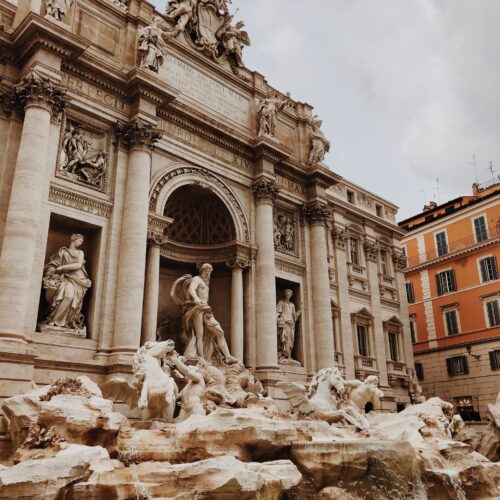
Get ready to be Amphitheatrilled when visiting Amphitheatre of Pompeii, Rome’s Colosseum or the Verona Arena!
These massive oval-shaped structures could seat tens of thousands of spectators and hosted many events, from gladiatorial contests to theatrical performances, music concerts, and public speeches.
These days, many of these ancient amphitheaters still stand, offering a glimpse into the grandeur and spectacle of the past. From Italy to Greece, Spain to Austria, and beyond, these architectural marvels continue to inspire awe and wonder in visitors worldwide.
Here are ancient amphitheaters to explore:
- Colosseum – Rome, Italy: The Colosseum is perhaps the most famous ancient amphitheater, built in 70-80 AD. It could seat over 50,000 spectators and was used for gladiatorial contests, animal hunts, and public spectacles. It was a symbol of the power and wealth of the Roman Empire and is now a popular tourist attraction.
- Theater of Dionysus – Athens, Greece: The Theater of Dionysus was built in the 6th century BC and could seat up to 17,000 spectators. It was the birthplace of Greek drama and hosted the performances of famous playwrights such as Aeschylus, Sophocles, and Euripides. The theater was also the site of the Great Dionysia, an annual festival in honor of the god Dionysus.
- Amphitheater of El Djem – Tunisia: The Amphitheater of El Djem was built in the 3rd century AD and could seat up to 35,000 spectators. It was the third-largest Roman amphitheater in the world and was used for gladiatorial contests and other public spectacles. Today, it is a popular tourist attraction and a UNESCO World Heritage site.
- Verona Arena – Verona, Italy: The Verona Arena was built in the 1st century AD and could seat up to 30,000 spectators. It was used for gladiatorial contests, animal hunts, and public spectacles. Today, it is one of the best-preserved Roman amphitheaters for operas, concerts, and other cultural events.
- Pula Arena – Croatia: The Pula Arena was built in the 1st century AD and could seat up to 23,000 spectators. It was used for gladiatorial contests, animal hunts, and public spectacles. Today, it is one of the best-preserved Roman amphitheaters and is used for concerts, film festivals, and other cultural events.
- Amphitheatre of Pompeii – Pompeii, Italy: The Amphitheatre of Pompeii was built in the 2nd century BC and could seat up to 20,000 spectators. It was used for gladiatorial contests and other public spectacles and was a significant entertainment source for the ancient city of Pompeii. Today, it is a popular tourist attraction and a UNESCO World Heritage site.
- Nîmes Arena – Nîmes, France: The Nîmes Arena, also known as the Arena of Nîmes or the Amphitheatre of Nîmes, was built in the 1st century AD and could seat up to 24,000 spectators. It was used for gladiatorial contests and other public spectacles and is one of France’s best-preserved Roman amphitheaters.

- Amphitheatre of Capua – Santa Maria Capua Vetere, Italy: The Amphitheatre of Capua was built in the 1st century AD and could seat up to 60,000 spectators, making it the second-largest Roman amphitheater after the Colosseum. It was used for gladiatorial contests and other public spectacles and symbolized the power and influence of the ancient city of Capua.
- Jerash Amphitheater – Jerash, Jordan: The Jerash Amphitheater, also known as the South Theater, was built in the 2nd century AD and could seat up to 3,000 spectators. It was used for performances of Greek plays, Roman dramas, and other cultural events, and it is one of the best-preserved Roman amphitheaters in the Middle East.
- Amphitheatre of Tarragona – Tarragona, Spain: The Amphitheatre of Tarragona was built in the 2nd century AD and could seat up to 15,000 spectators. It was used for gladiatorial contests and other public spectacles. It was a significant cultural and entertainment center for the ancient city of Tarraco, the capital of the Roman province of Hispania Citerior. Today, it is a popular tourist attraction and a UNESCO World Heritage site.

- Amphitheatre of Herod Atticus – Athens, Greece: The Amphitheatre of Herod Atticus, also known as the Odeon of Herodes Atticus, was built in 161 AD and could seat up to 5,000 spectators. It was built in memory of Herod Atticus’ wife and hosted musical and theatrical performances during the Athens Festival, an annual celebration of the arts.
- Faleria Amphitheater – Falerii Novi, Italy: The Faleria Amphitheater was built in the 1st century AD and could seat up to 3,000 spectators. It was used for gladiatorial contests and other public spectacles, and it is one of the best-preserved Roman amphitheaters in central Italy.
- Amphitheater of Mérida – Mérida, Spain: The Amphitheater of Mérida was built in the 1st century AD and could seat up to 15,000 spectators. It was used for gladiatorial contests and other public spectacles and is one of Spain’s most well-preserved Roman amphitheaters. It is part of the Archaeological Ensemble of Mérida, a UNESCO World Heritage site.
- Amphitheater of Carnuntum – Petronell-Carnuntum, Austria: The Amphitheater of Carnuntum was built in the 2nd century AD and could seat up to 13,000 spectators. It was used for gladiatorial contests and other public spectacles and was an important center of entertainment and culture in the Roman province of Pannonia.
- Amphitheater of Philippopolis – Plovdiv, Bulgaria: The Amphitheater of Philippopolis was built in the 2nd century AD and could seat up to 7,000 spectators. It was used for gladiatorial contests and other public spectacles and is one of Bulgaria’s best-preserved Roman amphitheaters. It is in the Old Town of Plovdiv, a UNESCO World Heritage site.
Did you know?
Ancient amphitheaters were not only used for entertainment purposes but also for public punishment.
In Rome, for example, the Colosseum was sometimes used as a venue for executions, and prisoners would be thrown to wild animals or made to fight gladiators in front of a cheering crowd.
In ancient Greece, the theater of Dionysus in Athens was used as a court of law, and the audience members would serve as the jury.
These uses of amphitheaters show that they were not just venues for entertainment but also played an essential role in the administration of justice and the exercise of political power.
A little history:
The ancient Greeks first developed amphitheaters in the 5th century BCE to evolve their outdoor theaters. The earliest known amphitheater is the Theater of Dionysus in Athens, which was built in the 4th century BCE and could seat up to 17,000 spectators.
However, the Romans popularized amphitheaters as venues for public entertainment and civic gatherings. The Colosseum in Rome, built in the 1st century CE, is the most famous ancient arena, and it could seat up to 80,000 spectators.
The Romans used amphitheaters not only for gladiatorial contests and other forms of entertainment but also for political rallies, religious ceremonies, and public executions.
Many of these structures were built using advanced engineering techniques, including arches, vaults, and concrete, and they featured elaborate decorations such as statues, reliefs, and frescoes.
Despite their enduring popularity, however, the decline of the Roman Empire in the 5th century CE led to the deterioration of arenas, and many were abandoned, destroyed, or repurposed over time.
Nonetheless, they continue to fascinate us with their grandeur and spectacle, and many ancient amphitheaters have been preserved or restored as important cultural landmarks.


